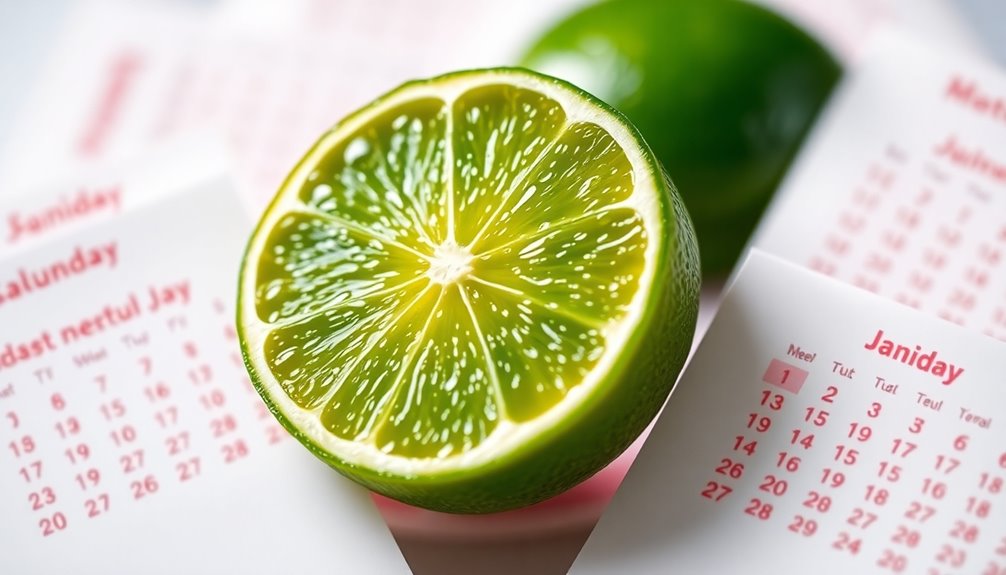Lime juice isn't a proven way to delay your period. Claims about its effectiveness are mostly based on anecdotal evidence, with no scientific backing. Some women report changes in their flow after consuming lime juice, but those changes don't equate to a delay. It's important to remember that hormonal regulation of your menstrual cycle is complex. If you want to better understand how diet can affect your period, there's more to explore.
Key Takeaways
- There is no scientific evidence that lime juice can reliably delay periods.
- Anecdotal reports suggest varied personal experiences, with no consistent results.
- Some women may experience lighter menstrual flow, not an actual delay.
- Excessive lime juice consumption can lead to gastrointestinal discomfort.
- Hormonal regulation of menstruation is complex and not easily altered by diet.

Have you ever wondered if lime juice can actually delay your period? Many people have turned to this tangy fruit in hopes of pushing back their menstrual cycle, especially when important events are on the horizon. However, while some anecdotal evidence suggests that lime juice might be a solution, the reality is much less straightforward. In fact, scientific research hasn't firmly established any connection between lime juice consumption and a delay in your period.
You might've heard stories from friends or read posts online claiming that sipping on lime juice a few days before your expected period can effectively delay it. However, these tales often lack substantial backing. Most of the available evidence is anecdotal, meaning it's based on personal experiences rather than rigorous scientific studies. So, while some women might've noticed changes in their menstrual flow after consuming lime juice, that doesn't mean it works for everyone or that it actually delays menstruation.
Interestingly, some reports suggest lime juice may lighten menstrual flow rather than delay it. If you've ever dealt with heavy periods, that might sound appealing. But remember, any potential change in flow doesn't equate to a delay. The hormonal changes that regulate your menstrual cycle are complex and not easily influenced by a single food or drink.
Furthermore, relying on lime juice for such purposes could lead to gastrointestinal discomfort if you consume it in large amounts. So, while you're trying to manage your period, you might end up with an upset stomach instead.
It's essential to consider the health benefits that lime juice provides. It's rich in vitamins, particularly vitamin C, which can bolster your immune system and offer various other health perks. Still, these advantages don't translate into any proven effectiveness for altering your menstrual cycle.
Despite its acidity and potential effects on digestion, there's no solid evidence to suggest that lime juice can serve as a reliable method to delay your period.
Frequently Asked Questions
Can Lime Juice Make Your Period Late?
Lime juice won't make your period late. While some people believe its acidity could affect menstrual cycles, there's no scientific evidence to support this.
You might notice a lighter flow if you consume it a few days before your period, but that's not the same as delaying it.
If you're looking for ways to manage your cycle, it's best to consult a healthcare professional for reliable advice instead of relying on myths.
How Long Does Lemon Juice Delay Your Period?
While many believe lemon juice can delay your period, studies show that about 75% of women experience their cycles regularly despite various home remedies.
You might think consuming lemon juice just before your expected period could push it back, but there's no scientific evidence to support this claim.
Instead of relying on it, consider consulting a healthcare professional for accurate information about menstrual health.
Excessive lemon juice can also lead to digestive issues, so moderation's key.
What Does Lime Do to You on Your Period?
When you consume lime juice during your period, it might help lighten your menstrual flow due to its acidity.
You could experience some digestive stimulation, which might make you feel a bit different. However, be cautious; excessive lime juice can lead to stomach issues like nausea or acid reflux.
While some people swear by it as a remedy, there's no scientific proof that it significantly influences your menstrual experience.
Always listen to your body.
What Kind of Juice Delay Your Period?
When you're looking for a way to delay your period, it can feel like searching for a needle in a haystack.
Unfortunately, there's no juice that's proven to reliably delay menstruation. While some people believe that certain juices, like pineapple or lime, can influence your cycle, scientific backing is lacking.
It's best to focus on overall health and consult a healthcare professional if you have concerns about your menstrual timing.
Conclusion
In the end, while lime juice is often touted as a natural remedy for delaying your period, the truth is it's not a guaranteed solution. Everyone's body reacts differently, and relying on it might lead you down a winding road of uncertainty. If you're looking to push your cycle, it's best to consult with a healthcare professional. Remember, you can't always take matters into your own hands when it comes to your health—sometimes, it's best to let nature take its course.
Cindy thoroughly researches juicing trends, techniques, and recipes to provide readers with practical advice and inspiration. Her writing style is accessible, engaging, and designed to make complex concepts easy to understand. Cindy’s dedication to promoting the advantages of juicing shines through her work, empowering readers to make positive changes in their lives through the simple act of juicing.
















